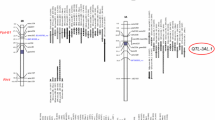Abstract
Several methods of interval mapping of QTLs underlying endosperm traits based on random hybridization designs and the triploid genetic model are proposed. The basic idea is: plants (or lines) from a population with known marker genotype information are randomly hybridized to generate a population of hybrid lines for endosperm QTL mapping; a mixture of seeds of each hybrid line is measured for the endosperm trait to get the mean of the line; then endosperm QTL mapping and effect estimation is performed using the endosperm trait means of hybrid lines and the marker genotype information of parental plants (or lines). The feasibility and efficiency of the methods are examined by computer simulations. Results show that the methods can precisely map endosperm QTLs and unbiasedly and efficiently estimate the three effects (additive effect, first dominant effect, second dominant effect) of endosperm QTLs.
Similar content being viewed by others
References
Sadimantara G R, Abe T, Sasahar T. Genetic analysis of high molecular weight protein in rice (Oriza sativa L.) endosperm. Crop Sci, 1997, 37: 1177–1180
Mazur B, Krebbe E and Tingey S. Gene discovery and product development for grain quality traits. Science, 1999, 285: 372–375
Tan Y F, Li J X, Yu S B, et al. The three important traits for cooking and eating quality of rice grains are controlled by a single locus in an elite rice hybrid, Shanyou 63. Theor Appl Genet, 1999, 99: 642–648
Wang X L, Larkins B A. Genetic analysis of amino acid accumulation in opaque-2 maize endosperm. Plant Physiol, 2001, 125: 1766–1777
Lou X Y, Zhu J. Analysis of genetic effects of major genes and polygenes on quantitative traits. II. Genetic models for seed traits of crops. Theor Appl Genet, 2002, 105: 964–971
Mo H D. Genetic expression for endosperm traits. In: Proceedings of the 2nd International Conference on Quantitative Genetics. Sunderland: Sinauer Associates, 1987. 478–487
Sourdille P, Perretant M R, Charme G, et al. Linkage between RFLP markers and genes affecting kernel hardness in wheat. Theor Appl Genet, 1996, 93: 580–586
Parker G D, Chalmers K J, Rathjen A J, et al. Mapping loci associated with flour colour in wheat (Triticum aestivum L.). Theor Appl Genet, 1998, 97: 238–245
Araki E, Miura H and Sawada S. Identification of genetic loci affecting amylose content and agronomic traits on chromosome 4A of wheat. Theor Appl Genet, 1999, 98: 977–984
Sene M, Thevenot C, Hoffmann D, et al. QTL for grain dry milling properties, composition and vitreousness in maize recombinant inbred lines. Theor Appl Genet, 2001, 102: 591–599
Wang X L, Woo Y M, Kim C S, et al. Quantitative trait locus mapping of loci influencing elongation factor 1 alpha content in maize endosperm. Plant Physiol, 2001, 125: 1271–1282
Tan Y F, Sun M, Xing Y Z, et al. Mapping quantiative trait loci for milling quality, protein content and color characteristics of rice using a recombinant inbred line population derived from an elite rice hybrid. Theor Appl Genet, 2001, 103: 1037–1045
Wu R L, Lou X Y, Ma C X, et al. An improved genetic model generates high-resolution mapping of QTL for protein quality in maize endosperm. Proc Natl Acad Sci USA, 2002, 99: 11281–11286
Wu R L, Ma C X, Gallo-Meagher M, et al. Statistical methods for dissecting triploid endosperm traits using molecular markers: an autogamous model. Genetics, 2002, 162: 875–892
Xu C, He X, Xu S. Mapping quantitative trait loci underlying triploid endosperm traits. Heredity, 2003, 90: 228–235
Kao C H. Multiple-interval mapping for quantitative trait loci controlling endosperm traits. Genetics, 2004, 167(4): 1987–2002
Hu Z Q, Xu C W. A new statistical method for mapping QTLs underlying endosperm traits. Chin Sci Bull, 2005, 14: 1470–1476
Dempster A P, Laird N M, Rubin D B. Maximum likelihood from incomplete data via EM algorithm. J R Stat Soc Ser B, 1977, 39: 1–38
Churchill G A, Doerge R W. Empirical threshold values for quantitative trait mapping. Genetics, 1994, 138: 963–971
Zhang Y M, Xu S Z. Mapping quantitative trait loci in F2 incorporating phenotypes of F3 progeny. Genetics, 2004, 166:1981–1993
Zeng Z B. Precision mapping of quantitative trait loci. Genetics, 1994, 136: 1457–1468
Kao C H, Zeng Z B, Teasdale R D. Multiple interval mapping for quantitative trait loci. Genetics, 1999, 152: 1203–1216
Author information
Authors and Affiliations
Corresponding author
About this article
Cite this article
Wen, Y., Wu, W. Methods for mapping QTLs underlying endosperm traits based on random hybridization design. CHINESE SCI BULL 51, 1976–1981 (2006). https://doi.org/10.1007/s11434-006-2080-6
Received:
Accepted:
Issue Date:
DOI: https://doi.org/10.1007/s11434-006-2080-6




